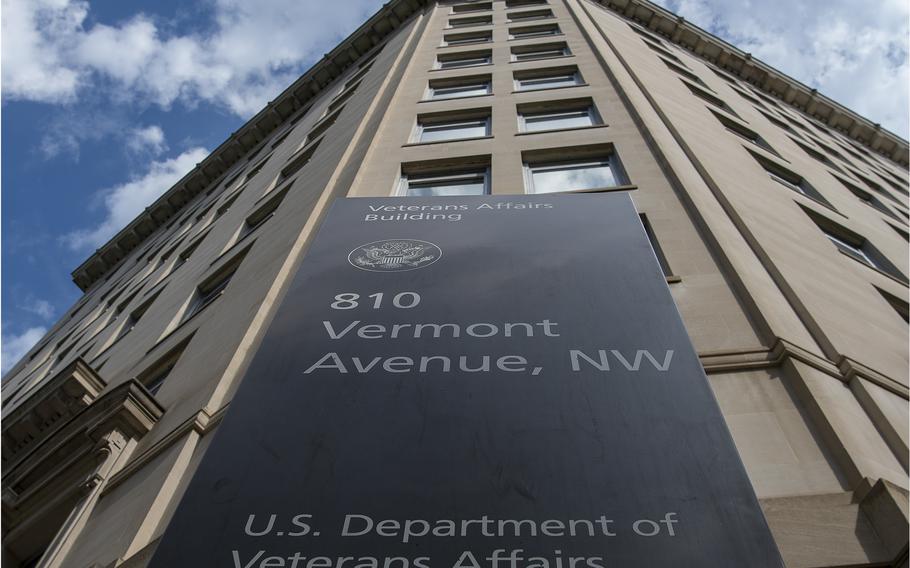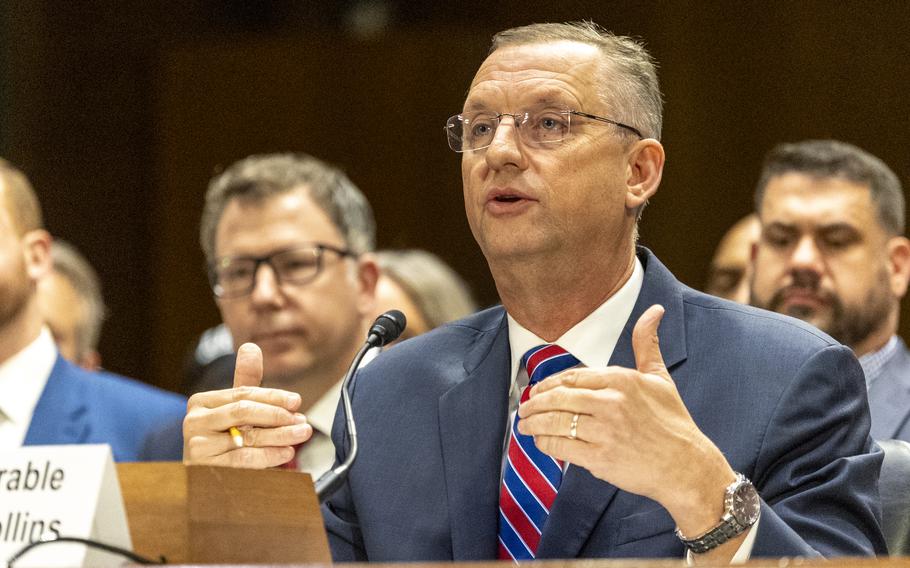
The Department of Veterans Affairs headquarters building in Washington, D.C. (Carlos Bongioanni/Stars and Stripes)
WASHINGTON — The Department of Veterans Affairs is proposing a 4% increase for program funding in fiscal 2026, representing a $5 billion jump in spending as many other federal agencies brace for steep spending cuts.
An overview of budget priorities by the VA for the next fiscal year was revealed in the $1.7 trillion “skinny budget” that the White House released for non-defense agencies.
The preliminary spending plan also shows large year-over-year cuts planned at other federal agencies, including a 30% budget decrease at the Interior Department and 35% at the Labor Department, according to budget documents.
But the VA blueprint shows funding increases to modernize the agency’s digital medical records system and to support programs to reduce veteran homelessness through rent subsidies and other services.
The House Veterans’ Affairs Committee will have its first formal look at VA budget requests for the next two years at an oversight hearing scheduled for Thursday. The hearing will offer a broad look at anticipated discretionary spending in fiscal 2026, which starts Oct. 1.
Discretionary spending is the optional part of the federal budget that is approved by Congress through a series of annual appropriations.
VA Secretary Doug Collins said the additional funds will help support veterans’ care at the VA and in communities, as well as pay for infrastructure.
“We’ve got to take care of our veterans,” he said.

Department of Veterans Affairs Secretary Doug Collins testifies May 6, 2025, during a hearing of the Senate Committee on Veterans’ Affairs. (Eric Kayne/Stars and Stripes)
The federal budget overall would increase national security spending next year by 13% and decrease non-defense discretionary spending by more than 7%, according to the White House.
But the VA also plans to trim spending through a freeze on purchasing new computer systems and by making additional workforce cuts targeting administrative positions.
Under the VA budget plan, discretionary spending would increase from the $129 billion budget that Congress adopted for fiscal 2025 to roughly $134 billion in 2026, according to budget documents. About $3 billion would pay for medical care improvements, though details have yet to be released.
The VA is proposing to add $2 billion for the medical records upgrade. Delaying or canceling computer system purchases could save an estimated $500 million.
The agency intends to work with the Department of Government Efficiency to review legacy computer systems, which number more than 1,000, with the goal to end redundancy of IT networks and software, according to budget documents.
The 2026 spending plan anticipates another $37 million in savings from additional workforce cuts with a focus on eliminating “bureaucratic overhead” and programs that support ”DEI,” which are activities that promote diversity, equity and inclusion.
Collins said at a Senate Veterans’ Affairs Committee hearing this week that 300,000 VA jobs are considered essential and not subject to the cuts. Those roles include doctors, nurses and other medical professionals who provide direct clinical care to veterans.
“The bureaucracy at the VA has hampered some of the department’s successes,’‘ said Sen. Jerry Moran, R-Kan., chairman of the committee. ‘‘More work remains to make this department — the second largest in the federal government — perform to the level that veterans and their families deserve.”
The VA also would inject $1.1 billion into VA programs that provide rent subsidies and other housing assistance to address homelessness among veterans.
In addition, about $50 billion for the toxic exposures fund would be shifted from mandatory costs to the discretionary budget, an accounting move that Republicans argue gives Congress more control over spending. The toxic exposures fund covers disability benefits for veterans who were injured or became ill after exposure to hazardous materials during active duty, including burn pits, radiation and industrial solvents.
Workforce cuts planned in fiscal 2026 are expected to follow a major restructuring in the summer for cutting VA staff by up to 83,000 full-time employees, according to an internal VA memo. The agency has pledged to target jobs that are non-essential and would not directly impact patient care or the delivery of veterans benefits.
“In the old days, way back in 2024, discussions in Congress about the need to reform VA were often just a thinly veiled request for more employees. But the department’s history shows that adding more employees to the system doesn’t automatically mean better results,” Collins told lawmakers this week at the Senate hearing at which he testified about plans to downsize the agency.
In March, Congress passed the full-year Continuing Appropriations and Extensions Act that provides a funding framework for the budget work that lies ahead. The act ensures $420.7 billion in VA funding will become available on Oct. 1.